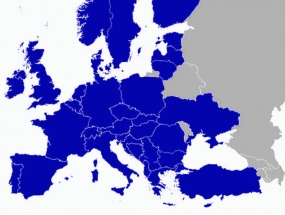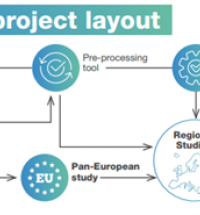FlexPlan - Advanced Methodology and Tools Taking Advantage of Storage and FLEXibility in Transmission and Distribution Grid PLANning
Client: European Commission (Belgium), European Union
Type: Project
Finishing date: September 2022 (March 2023)
Team: 13 consortium members lead by RSE (Italy); EKC team: Dragana Orlic - Coordinator of EKC’s activities within the Project, S. Markovic, M. Ivanovic, B. Lekovic, B. Sijakovic, B. Brdjanin, M. Kostic
FLEXPLAN aims at creating a new tool for optimizing transmission and distribution grid planning, considering the placement of flexibility elements as an alternative to traditional grid planning. This approach aims at helping to reduce overall power system costs i.e. infrastructure deployment and operation costs, the latter in terms of procurement of energy and system services.
FlexPlan is going to take into account environmental impact and footprint (impact on air quality for thermal generation, carbon footprint, impact on landscape of new T&D lines).
A pre-processing tool is also created to determine location, size and associated costs for storage and flexible demand candidates. The new planning tool is first validated and then used for analysing six detailed regional scenarios at 2030-2040-2050 in order to assess the potential role of storage and flexible resources. Pan-European scenarios are preliminarily elaborated in order to provide border conditions for the regional cases. Regulatory conclusions are drawn to analyse whether opportune incentivisation procedures could be put in place by the regulators wherever some consistent advantages are demonstrated.
The approach chosen is global as it considers at the same time, the increased need of flexibilities in the system (mainly related to balance of supply and demand in electricity markets, provision of existing and future system services and allowance of a dynamic control of electricity flows) and the sources of flexibilities (RES, demand-response, grid and new storages). The chosen global approach addresses all system requirements to capture the synergies proposed by the different solutions in order to avoid stand-alone solutions that might be less efficient in terms of overall efficiency.
The project satisfies determined goals through separate Work Packages (WPs):
WP1. Advanced planning tool specifications
In this WP, functional modelling specifications for the new advanced planning tool will be defined, taking into account innovative mathematical and modelling features, best planning strategy, T&D integrated planning and environmental concerns.
WP2. Analyses of capabilities and operation of storage and flexible demand at target years
WP2 aims at identifying and characterizing both flexibility technologies (T2.2) and the potential services that can be provided (T2.1). On this basis flexibility elements analysis methodology will be developed and implemented in a tool (T2.3) so that case by case studies can be systematically performed (T2.4). The final aim of this tool module is to generate the input data of the flexibility elements required for planning studies
WP3. Planning tool implementation and testing
The main objectives of this work package are: (1) to design an efficient software architecture for the new planning tool; (2) to implement the new planning tool software; (3) to test the planning tool software; (4) to assist the implementation of the six regional cases in WP5, upgrading the software when needed.
WP4. Pan-European Scenarios at Target Years
The main objectives of this work package are: (1) the identification of relevant aspects that influence energy consumption and supply and therefore transmission grid expansion measures; (2) the definition of relevant scenarios of the European power system at target years that are outlined by different boundary conditions; (3) the generation of simplified input data for pan EU simulations; (4) to perform an analysis of the impact of flexibility elements on transmission grid expansion measures simplified pan EU simulation studies are carried out to determine the boundary conditions for more detailed regional case studies in WP 5
WP5. Regional cases and assessment of advantages over traditional planning
The main objectives of this work package is to develop optimal regional grid architectures in target years 2030, 2040 and 2050 which incorporates support from flexibility elements located both at transmission and distribution levels by usage of the new planning tool which takes also into account environmental impact analysis
WP6. Regulatory Analysis
This work package assesses and identifies current and future (2030+) pan-European regulatory conditions and political targets relevant in order to set an optimal environment for the real implementation of the planning tool realized by the FlexPlan project. Theoretical potentials (enablers) and practical real-world limitations (barriers) will be also investigated by taking into account both regulatory trends (at European as well as at national level) and current TSO/DSO planning practice.
EKC participates in WP2, WP3, WP4 and WP5:
- providing analytical services in power system modeling and analyses at Pan-European and regional context
- providing services in testing of the software tools
- providing services related to preparation of starting models for implementation of the planning tool from WP3 and development of optimal regional grid architectures.
Type of services provided:
EKC’s tasks are as follows:
Within WP2:
- To organize and carry out analyses of the 2030/40/50 scenarios with the pre-processor module developed in T2.3 with the aim to create a dataset of cost and performance (CAPEX, OPEX, LCOE, lifetime and technical performance) for all the identified flexibility technologies and services. These datasets will be input data for the regional cases in WP5.
Within WP3:
- To support the testing of the main tool developed in T3.3
Within WP4:
- To support data harmonization and simplification
- To support simulation at Pan-European level
- To support preparation of the input data for regional cases
Within WP5:
- To support preparation of common modeling and procedures
- To organize and carry out simulations and development of the optimal grid architecture for the case of SEE region
General:
Participation in common meetings, preparation of the excerpts and papers, participation on scientific conferences


